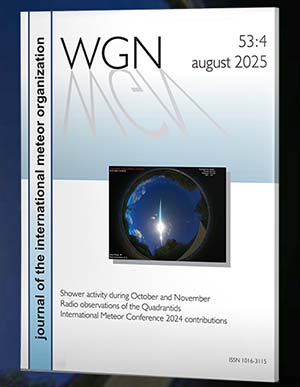No matter where you live, the first half of
December provides some of the best meteor activity of the year. In the northern
hemisphere the sporadic rates are still strong plus you can also count on strong
activity from the Geminids, which peak on December 14. There are also several
minor radiants that add a few meteors each hour. All of these centers of activity
are located high in the sky during the early morning hours this time of year. The
night of December 13/14 is no doubt the best night of the year to view meteor
activity. The moon is favorable during this entire period. After the 15th, the
shower activity suddenly wanes and a great majority of the activity seen is
sporadic. Approaching Christmas the moon become a major factor and ruins the
maximum of the Ursid shower.
As seen from the southern hemisphere the sporadic rates are increasing toward a
January maximum. Shower rates are also good but the Geminids suffer a bit from
the lower elevation seen from southern locations. Still with the warmer weather
now occurring south of the equator, December is a great time to view celestial
fireworks.
During this period the moon reaches its first
quarter phase on Monday December 17. At this time the moon will be located ninety
degrees east of the sun and will set near midnight local standard time (LST). This
weekend the moon will not be a factor as it sets before the best meteor activity
occurs during the morning hours. Toward the end of this period the waxing gibbous
moon will only allow a couple of hours of dark skies between moonset and the start
of morning twilight.
The estimated total hourly rates for evening observers
this week is near three for those located in the mid-northern hemisphere (45 N) and
one for observers from the mid-southern hemisphere (45 S). For morning observers
the estimated total hourly rates should be near twenty-five for those located in the
mid-northern hemisphere (45 N) and fifteen for those viewing from the mid-southern
hemisphere (45 S). These rates assume that you are watching from rural areas away
from all sources of light pollution. The actual rates will also depend on factors
such as personal light and motion perception, local weather conditions, alertness
and experience in watching meteor activity. Evening rates are reduced by moonlight.
The radiant positions and rates listed below are exact
for Saturday night/Sunday morning December 15/16. These positions do not change
greatly day to day so the listed coordinates may be used during this entire period.
Most star atlases (available at science stores and planetariums) will provide maps
with grid lines of the celestial coordinates so that you may find out exactly where
these positions are located in the sky. A planisphere or computer planetarium program
is also useful in showing the sky at any time of night on any date of the year.
Activity from each radiant is best seen when it is positioned highest in the sky,
either due north or south along the meridian, depending on your latitude. It must
be remembered that meteor activity is rarely seen at the radiant position. Rather
they shoot outwards from the radiant so it is best to center your field of view so
that the radiant lies at the edge and not the center. Viewing there will allow you to
easily trace the path of each meteor back to the radiant (if it is a shower member)
or in another direction if it is a sporadic. Meteor activity is not seen from radiants
that are located below the horizon. The positions below are listed in a west to east
manner in order of right ascension (celestial longitude). The positions listed first
are located further west therefore are accessible earlier in the night while those
listed further down the list rise later in the night.
The following showers are expected to be active this week:
The Earth has now passed the stream of particles produced by comet 2P/Encke,
which gives us the Taurid meteors each autumn. As we enter the month of December
we again recognize the ever present Antihelion (ANT) radiant. This large,
diffuse radiant is now centered at 06:28 (097) +23. This position lies in western
Gemini near the third magnitude star Mu Geminorum. This area
of the sky is best placed on the meridian near 0100 local standard time (LST). One
can expect to see approximately three shower members per hour as seen from the
northern hemisphere and two per hour from south of the equator. At 30km/sec., the
average Antihelion meteor travels slowly through the skies.
The Monocerotids (MON) are currently active from a radiant located at
07:00 (105) +08. This area of the sky is located in northeastern Monoceros, ten
degrees northwest of the zero magnitude star Procyon (Alpha Canis Minoris). These meteors
are best seen near 0100 LST when the radiant lies highest above the horizon. The
peak for the Monocerotids was December 8 and weak activity continues until December
16. This shower would be equally well seen from both hemispheres. Current rates are
most likely near one per hour. At 42 km/sec. the Monocerotids produce
meteors of average velocity.
The Geminids (GEM) peak(ed) on the night of December 13/14. Rates will quickly
fall this weekend and the show will basically be over by the 17th. Current rates would be near
five shower members per hour as seen from the mid-northern latitudes and only one
per hour from the mid-southern latitudes. The current radiant is located at 07:36
(114) +33. This area of the sky is located in northern Gemini, just north of the
second magnitude star Castor (Alpha Geminorum). These meteors are best seen near
0200 LST when the radiant lies highest above the horizon. This shower is best
suited for the Northern Hemisphere but some activity can be seen south of the
equator when the radiant culminates low in the northern sky. At 35 km/sec. the
Geminids produce meteors of average velocity.
The Sigma Hydrids (HYD) may be weakly seen from a radiant located at 08:44
(131) +01. This area of the sky is located in western Hydra, only one degree
south of the five faint stars that make up the “head” of Hydra. These meteors
are best seen near 0300 local standard time when the radiant lies highest above
the horizon. The predicted peak for the Sigma Hydrids occurred on December 12 when
the ZHR reaches two. Current rates are expected to be less than one shower member
per hour. At 58 km/sec. the Sigma Hydrids produce meteors of average to swift velocity.
The Coma Berenicids (COM) are active from a radiant located at 11:32 (173)
+26. This area of the sky is located in northwestern Coma Berenices, six degrees
northeast of the third magnitude star Zosma (Delta Leonis). This
radiant is probably responsible for the many reports of activity in Leo during
the month of December. Current rates would be near one shower member per hour.
These meteors are best seen near 0600 local standard time when the radiant lies
highest above the horizon. At 65 km/sec. the Coma Berenicids will usually produce
meteors of swift velocity.
Sirko Molau’s study of video radiants has revealed activity during the
period December 19-24, from an area in northern Virgo. Maximum occurs on
December 20 with the radiant located at 13:28 (202) +09. This position lies
five degrees southeast of the third magnitude star Vindemiatrix (Epsilon
Virginis). This radiant is best placed during the last dark hour before dawn
when it lies highest in a dark sky. Rates are most likely less than one shower
member per hour. no matter your observing location. At 62km/sec., the average
meteor from this radiant would be swift.
Sporadic rates have reached maximum for observers in the northern
hemisphere and are now slowly rising for those located south of the equator. One
would expect to see approximately fifteen random meteors during the last hour before
dawn from rural observing sites in the mid-northern hemisphere (45 N). During the
first dark hour after the end of evening twilight, perhaps three random meteors can
be seen per hour. As seen from the mid-southern hemisphere (45 S) late morning rates
would now be near eleven per hour. During the first dark hour after the end of evening
twilight, perhaps one random meteors can be seen per hour. Evening rates are
reduced due to moonlight.
| SHOWER | DATE OF MAXIMUM ACTIVITY | CELESTIAL POSITION | ENTRY VELOCITY | CULMINATION | HOURLY RATE | CLASS* | RA (RA in Deg.) DEC | Km/Sec | Local Standard Time | North-South | Antihelion (ANT) | – | 06:28 (097) +23 | 30 | 01:00 | 3 – 2 | II | Monocerotids (MON) | Dec 08 | 07:00 (105) +08 | 42 | 01:00 | 1 – 1 | II | Geminids (GEM) | Dec 14 | 07:36 (114) +33 | 35 | 02:00 | 5 – 1 | I | Sigma Hydrids (HYD) | Dec 12 | 08:44 (131) +01 | 58 | 03:00 | <1 – <1 | II | Coma Berenicids (COM) | Dec 20 | 11:32 (173) +26 | 65 | 06:00 | 1 – <1 | II | Epsilon Virginids (Non-IMO Shower) | Dec 20 | 13:28 (202) +09 | 62 | 08:00 | <1 – <1 | IV |




 You saw something bright and fast? Like a huge shooting star? Report it: it may be a fireball.
You saw something bright and fast? Like a huge shooting star? Report it: it may be a fireball.  You counted meteors last night? Share your results with us!
You counted meteors last night? Share your results with us!  You took a photo of a meteor or fireball? You have a screenshot of your cam? Share it with us!
You took a photo of a meteor or fireball? You have a screenshot of your cam? Share it with us!  You caught a meteor or fireball on video? Share your video with us!
You caught a meteor or fireball on video? Share your video with us!